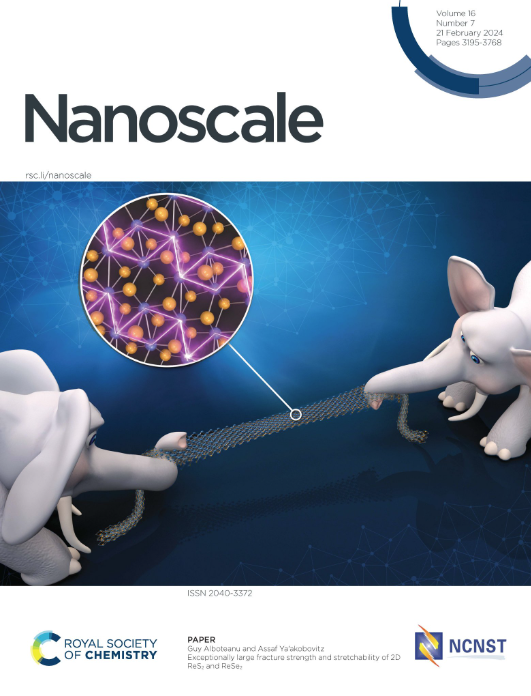Understanding Structure-Property Relationships in Coordination Polymers: A Comparative Study of Copper(II) and Zinc(II) Coordination mechanism
IF 5.8
3区 材料科学
Q1 CHEMISTRY, MULTIDISCIPLINARY
引用次数: 0
Abstract
Coordination polymers (CPs) are an interesting class of materials due to their tunable structure and electrical properties, where, however, the correlation between the former and latter are still not fully understood. Here we compare the structure and properties of CPs derived from copper(II) and zinc(II) ions coordinating a triphenylene derivative (OHPTP). To focus on the effect of the coordinating ion used and avoid possible differences due to the processing method, we synthesized the different CPs using a novel two-step technique, potentially scalable for applications in transistors, sensors, and photovoltaics: first, the organic ligand is deposited using a shear-coating technique which ensures uniform deposition on macroscopic scale. Then, in a second step, the sample is exposed to solutions of the metal ions, which can penetrate in the organic layer to coordinate with the ligand. Density functional theory (DFT) calculations show that Cu ions have a higher affinity for the ligand and form square-planar CP structures due to their d9 electronic configuration. Conversely, Zn ions can coordinate with the chelating ligands using only their empty 4s and 4p orbitals to achieve sp3 hybridisation, thus preferring to adopt a tetrahedral geometry and leading to less ordered structures with significantly hampered conductivity. FT-IR and UV-Vis spectra, XPS and conductive atomic force microscopy confirm the distinct coordination behaviour of Cu and Zn ions. Thermal stability analysis further shows that Zn-based CPs retain their structural integrity at temperatures up to 300°C, whereas Cu-based CPs degrade earlier. These results show how metal-ligand interactions impact CP properties, enhancing the understanding of structure-property relationships, and provide practical insights for designing CPs with desired electronic and thermal properties by varying the coordinating metal ions.铜(II)和锌(II)配位机理的比较研究
配位聚合物(CPs)由于其可调节的结构和电性能而成为一类有趣的材料,然而,前者和后者之间的相关性仍未完全了解。在这里,我们比较了铜(II)和锌(II)离子配位三苯衍生物(OHPTP)衍生的CPs的结构和性质。为了关注所使用的配位离子的影响并避免因处理方法而可能产生的差异,我们使用一种新的两步技术合成了不同的CPs,该技术有可能扩展到晶体管、传感器和光伏电池的应用中:首先,使用剪切涂层技术沉积有机配体,以确保宏观尺度上的均匀沉积。然后,在第二步中,将样品暴露于金属离子溶液中,金属离子可以穿透有机层以与配体配合。密度泛函理论(DFT)计算表明,Cu离子对配体具有较高的亲和力,并由于其d9电子构型而形成方形平面CP结构。相反,锌离子仅能利用其空的4s和4p轨道与螯合配体配位以实现sp3杂化,因此更倾向于采用四面体几何结构,导致结构不有序,电导率显著降低。FT-IR和UV-Vis光谱、XPS和导电原子力显微镜证实了Cu和Zn离子的明显配位行为。热稳定性分析进一步表明,锌基CPs在高达300°C的温度下保持其结构完整性,而cu基CPs降解得更早。这些结果显示了金属-配体相互作用如何影响CP的性质,增强了对结构-性质关系的理解,并为通过改变配位金属离子来设计具有所需电子和热性能的CP提供了实用的见解。
本文章由计算机程序翻译,如有差异,请以英文原文为准。
求助全文
约1分钟内获得全文
求助全文
来源期刊

Nanoscale
CHEMISTRY, MULTIDISCIPLINARY-NANOSCIENCE & NANOTECHNOLOGY
CiteScore
12.10
自引率
3.00%
发文量
1628
审稿时长
1.6 months
期刊介绍:
Nanoscale is a high-impact international journal, publishing high-quality research across nanoscience and nanotechnology. Nanoscale publishes a full mix of research articles on experimental and theoretical work, including reviews, communications, and full papers.Highly interdisciplinary, this journal appeals to scientists, researchers and professionals interested in nanoscience and nanotechnology, quantum materials and quantum technology, including the areas of physics, chemistry, biology, medicine, materials, energy/environment, information technology, detection science, healthcare and drug discovery, and electronics.
 求助内容:
求助内容: 应助结果提醒方式:
应助结果提醒方式:


